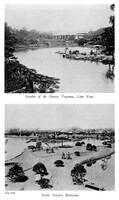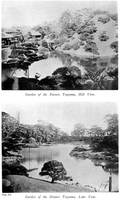The spot occupied by this garden is of some historical interest, having been presented by Iyeyasu, the first of the Tokugawa Shoguns, to one of his Ministers of State. It afterwards passed into the hands of the Daimio Tsuyama Matsudaira. The present owner is a wealthy silk merchant named Sugimura, but the garden is still known as the Tsuyama Garden. Three views of these grounds are given; the first being taken from across the narrower end of the lake, showing the outlet at the side of the residence, crossed by a wooden bridge. On the further side is a conical hillock shaped to represent Fuji-san, having its slopes adorned with rounded bushes and artificially trimmed pine-trees. This hill has a spur and the intermediate depression is crowded with stones and low bushes, high evergreens occupying the background. The lower view on Plate XX. is taken from in front of the building, looking across the whole length of the lake. Two important features may be observed in the form of peninsulas or promontories jutting out into the water, one in the right foreground, and the other in the distance on the left. Both are provided with a pebble-strewn beach, ornamented with low shrubs, numerous rocks, and a stone lantern. The distant promontory carries in addition a little arbour partly hidden amid trees. This may be considered the principal view of the garden, the further banks of the lake having a large rockery indicating the imaginary source of water. Plate XXI. presents another aspect of this composition, as seen from the opposite end looking towards the residence. It shows more clearly the further promontory with its sea-beach, lantern, and pine-tree stretching out over the water. The lower illustration on this Plate is taken from a public garden at Mukojima, called the Komatsushima Garden, receiving its name from the island of small pine-trees in the centre of the lake. It is somewhat bare and uninteresting in the details, but is given as an example of the more common kind of public garden frequented by holiday-makers.



